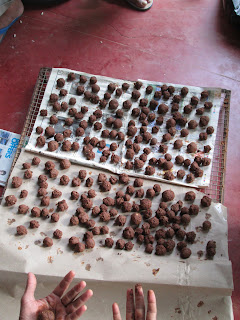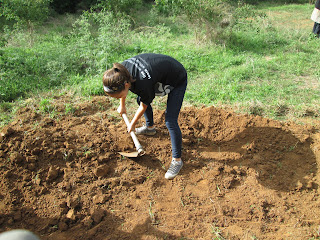All of us USAC study abroad students have a GREAT deal for housing in Bangalore. We basically have a whole apartment complex to ourselves, with 2 apartments on each floor. There is plenty of space and lots of light, and everything that we need is there for us to use. I have one other roommate and two suitemates who share the apartment with me, and we all get along great! They are all really nice girls who are excited to be in India.
The only downside is that we have to walk 40 minutes to Christ U, but we're able to pass lots of shops, restaurants, and stalls and get a better feel for the city and the culture.
Last night after I had gone to bed, I heard a loud, "OH SH*T!!" and when I opened my bedroom door to the living room, I saw the whole commons area and kitchen was flooded with about 1-2cms of water. One of the girls was doing their laundry and the washer was draining water onto the floor for about 20mins instead of down the drain in the floor where the water was supposed to be going. Luckily, our landlord provided us with floor mops in each apartment (it's like he knows this stuff is going to happen). I went next door to where three USAC guys are staying to take their mop, and we spent a good bit of time trying to push all of the water out the kitchen and onto the balcony. Finally we just decided to leave the fan on and the balcony door open to let the floor air out.
Here's some pictures of the apartment's common room! The top two pictures show the flooded area. In the third one you can see the two doors to the bedrooms. Both rooms have two beds, two desks, a wardrobe, and an attached shower/washroom.
The only downside is that we have to walk 40 minutes to Christ U, but we're able to pass lots of shops, restaurants, and stalls and get a better feel for the city and the culture.
Last night after I had gone to bed, I heard a loud, "OH SH*T!!" and when I opened my bedroom door to the living room, I saw the whole commons area and kitchen was flooded with about 1-2cms of water. One of the girls was doing their laundry and the washer was draining water onto the floor for about 20mins instead of down the drain in the floor where the water was supposed to be going. Luckily, our landlord provided us with floor mops in each apartment (it's like he knows this stuff is going to happen). I went next door to where three USAC guys are staying to take their mop, and we spent a good bit of time trying to push all of the water out the kitchen and onto the balcony. Finally we just decided to leave the fan on and the balcony door open to let the floor air out.
Here's some pictures of the apartment's common room! The top two pictures show the flooded area. In the third one you can see the two doors to the bedrooms. Both rooms have two beds, two desks, a wardrobe, and an attached shower/washroom.

















































